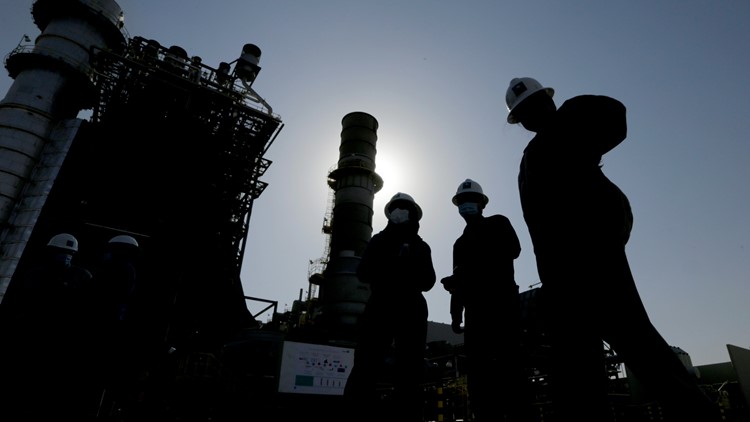TEXAS, USA — Oil prices soared nearly 6% on Monday after Saudi Arabia and other major oil producers said they will cut production by 1.15 million barrels per day from May until the end of the year. Shares in Asia were mixed.
According to AAA Texas, gas prices are starting to rise statewide as demand is already at summer levels.
Texas is seeing an average of $3.16 per gallon of gas, which is still 75 cents cheaper than this same time in 2022. Nationwide, the price of a gallon is $3.51.
New data from the Energy Information Administration shows fuel demand is at 9.15 million barrels per day, which is usually only seen during busy summer travel months.
"Crude oil increased...to over $70 in just a few days," said Daniel Armbruster, a spokesperson with AAA. "This is in addition to the more expensive summer-blend gasoline switchover."
U.S. benchmark crude oil rose $4.24 to $79.91 per barrel, or 5.6%, in electronic trading on the New York Mercantile Exchange. It rose $1.30 to $75.67 per barrel on Friday, ahead of the weekend meeting where members of the so-called OPEC+ group of oil exporting countries decided on the cuts, which are in addition to a reduction announced last October that infuriated the Biden administration.
Brent crude, the pricing basis for international oils, gained $4.35 to $84.24 per barrel, or 5.4%.
The cuts in oil output immediately pushed prices higher and were expected to boost gas prices, adding to strains in many countries where high fuel prices are a heavy burden. Higher oil prices also will complicate the efforts by central banks to rein in inflation.
“This will create both political waves across Europe and even higher general inflation in the USA, leading to renewed pressure on the Federal Reserve to keep hiking rates aggressively,” Clifford Bennett, chief economist at ACY Securities, said in a report.
European shares opened higher. Germany's DAX added 0.2% to 15,665.63 and the CAC40 in Paris climbed 0.5% to 7,356.77. Britain's FTSE 100 surged 0.8% to 7,694.79.
The future for the S&P 500 slipped 0.2% while the contract for the Dow Jones Industrial Average gained 0.3%.
In Asian trading, Tokyo's Nikkei 225 index gained 0.5% to 28,188.15, even after a quarterly survey by the Bank of Japan showed business sentiment among big Japanese manufacturers falling in the first quarter of this year. The headline measure of the “Tankan” showed positive sentiment falling to 1 from 7 in December, the worse quarterly result since December 2020.
Hong Kong's Hang Seng edged 9 points higher to 20,409.18, while the Shanghai Composite index rose 0.7% to 3,296.40. In South Korea, the Kospi fell 0.2% to 2,472.34.
Australia's S&P/ASX 200 advanced 0.6% to 7,223.00. Shares rose in Taiwan but edged lower in Bangkok.
Surveys of purchasing managers in emerging Asian markets declined last month as export orders weakened, adding to signs of fragility in the global economy.
“With global growth set to remain weak in the coming quarters, we expect manufacturing output in Asia to remain under pressure,” Shivaan Tandon of Capital Economics said in a commentary.
On Friday, the S&P 500 gained 1.4% Friday, rising 3.5% for the month, with tech stocks leading the way. Friday’s gains came after a report showed inflation slowed in February, though it was still high on a historical basis. A slowdown in inflation could give the Federal Reserve more leeway to take it easier on interest rates.
The Dow Jones Industrial Average rose 1.3%, while the Nasdaq composite climbed 1.7%. Big leaps for technology stocks drove a Nasdaq gain of 16.8% for the quarter.
High rates can undercut inflation but only by bluntly slowing the entire economy, which raises the risk of a recession. They also drag down prices for stocks, bonds and other investments.
Expectations for an easier Fed have helped Big Tech stocks in particular because high-growth stocks are seen as some of the biggest beneficiaries of lower rates. That's helped to prop up the S&P 500, where Big Tech stocks play an outsized role because of their massive size. Apple, Microsoft and Google's parent Alphabet each posted double-digit gains for March.
Adding to challenges for the Fed, the second-and third-largest U.S. bank failures in history rocked markets after depositors rushed to pull their money out of Silicon Valley Bank and Signature Bank. The runs have pushed investors to cast harsher scrutiny on banks globally in the hunt for seemingly weak links.
The banking industry’s troubles also could act like hikes to interest rates if they cause banks to pull back on lending, stifling hiring and growth for the economy.
In other trading Monday, the U.S. dollar rose to 133.50 Japanese yen from 133.28 yen late Friday. The euro strengthened to $1.0848 from $1.0844.



